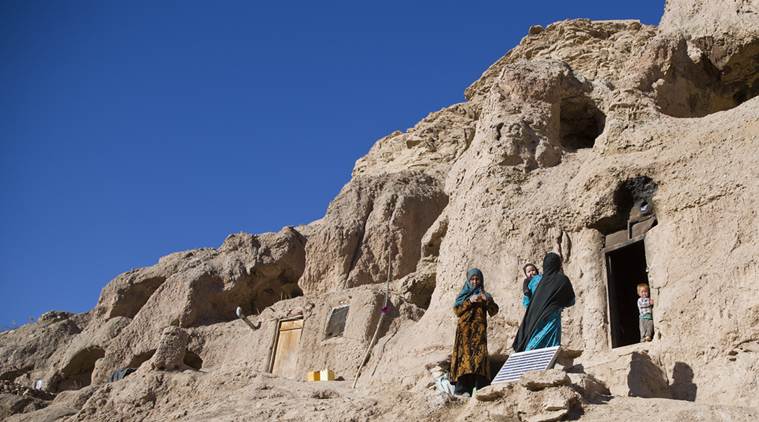- India
- International
Afghan cave dwellers brace against a shifting landscape
The couple moved here from neighbouring Maidan-Wardak province because they believed it was a stepping stone to a better future.
 The family, along with another 242 cave-dwelling households dotted around the capital of Bamiyan province, also called Bamiyan, could be forced to move soon. (AP Photos/Massoud Hossaini)
The family, along with another 242 cave-dwelling households dotted around the capital of Bamiyan province, also called Bamiyan, could be forced to move soon. (AP Photos/Massoud Hossaini)
Marzia and her husband Qadeer thought themselves lucky when they moved into a 1, 700-year-old Buddhist cave hand-carved into the side of a mountain in Afghanistan’s central highlands. It was clean and dry, warm in the winter, cool in the summer, and there was plenty of work on the local farms. But now, even this bare-bones way of life is threatened.
The family, along with another 242 cave-dwelling households dotted around the capital of Bamiyan province, also called Bamiyan, could be forced to move soon.
Watch What Else Is making News
They are what’s left of around 10,000 families who have been relocated over the past decade as part of the local government’s program to protect the unique man-made grottoes that it hopes will transform Bamiyan into a global tourist destination once Afghanistan’s war with the insurgent Taliban, now in its 16th year, is finally over.
The couple moved here from neighbouring Maidan-Wardak province because they believed it was a stepping stone to a better future.
“We had no money and my husband couldn’t get a job,” Marzia said as she breastfed her baby. “We left because we were poor.”

But 12 years later they are still living in the cave, along with their five children aged from 10 months to 8 years, including 6-year-old Freshta who hasn’t been the same since a land mine exploded close by her four years ago. Her mental development stopped and she spends most of her time lolling on the thin mat that covers the cave’s floor.
Any original features, such as the brightly-coloured geometric murals that were painted by the monks who created these caves, are long gone. They’ve been destroyed by time, the elements and the wear-and-tear of hundreds of years of habitation, including the fires that residents build for cooking and heat.
The provincial government is working with UNESCO to restore the valley’s eight significant sites, including the Ghulghulah fortress, believed to be Bamiyan’s original staging post on the old Silk Road that linked China to India. The fortress was razed by Genghis Khan’s hoards in the early 13th Century and never regained its glory.
“Life here is difficult,” Marzia, 30, said. Water must be fetched from a nearby stream, and a 9-volt battery charges a solar panel that provides light after dark. Cooking is done on a stove fuelled by a gas bottle. They have installed a door and a step up into the one room that all seven members of the family share. Smaller caves outside are used for storage.
On the rural outskirts of the city, amid the rutted fields where the province’s main potato crop is grown, the cave-dwellers do what they can with their meagre resources, determined that the next generation will have a better life.
As Shiite Muslims of the Hazara minority they have suffered historic persecution, but they have also benefited from immense largesse from international charities and governments.
Must Read
Apr 23: Latest News
- 01
- 02
- 03
- 04
- 05





























